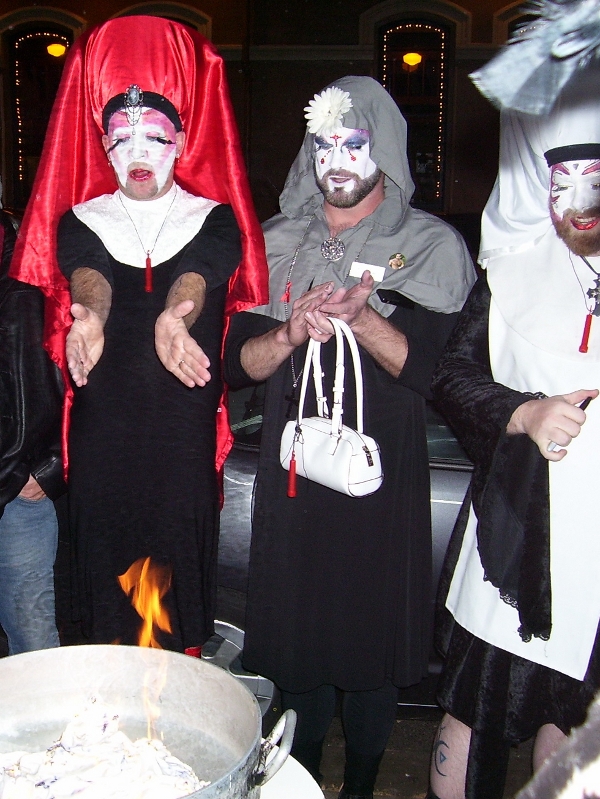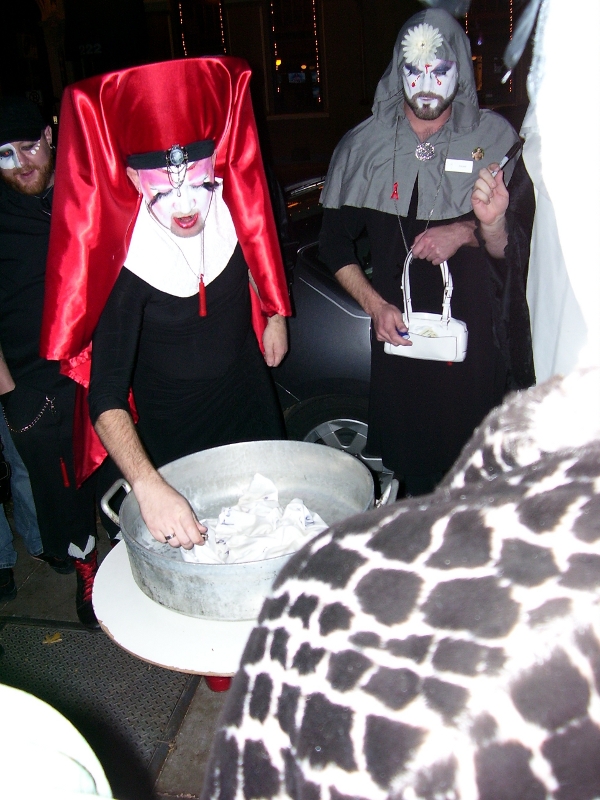Over the course of the evening, Sister Maya’s veil became covered with familiar epithets for gay, lesbian, bisexual, and transgender people as well as for Jews and people of color, while on Sister Krissy’s veil the names of the dead multiplied. Ultimately, the fate of the Veil of Remembrance was to be preserved in the order’s archives; the Veil of Shame, however, was the focus of a ritual that ended the evening.
We had arrived at C.C. Slaughter’s, a popular bar populated largely by gay men. Though it was relatively empty on a Tuesday, the Sisters still found plenty of people to talk with. After some time, Sister Maya disappeared, returning with the Veil of Shame in her hands and a clean veil on her head. The Sisters and a handful of others went outside, where a bartender had brought a metal tub and an open bottle of beer. One Sister placed the veil in the tub, and the bartender poured the beer over it. Sister Krissy Fiction, an ordained UCC minister in her life beyond the Sisters, led the gathered crowd in a chant to banish the epithets on the veil, and after some searching for a small lighter, Sister Polly Amorous set the cloth aflame.
A number of the Portland Sisters, and Sisters in other cities as well, have told me that the work they do in whiteface is an important part—and sometimes the central part—of what they call their spiritual lives. Like many people in the U.S., the Sisters describe their spirituality as an individual connection to the sacred that can be, but is not necessarily, connected to the beliefs and practices of organized religious groups. Some Sisters have what they term a “spirituality” beyond the Sisters themselves, characterized by everything from Christianity to an eclectic mix of practices to agnostic beliefs with no particular form of practice. Other Sisters describe their involvement with the movement itself as their form of spirituality or even of religion.

World AIDS Day is a particularly evident example of the very queer spirituality that is present in the Sisters. Elsewhere that evening, and earlier, the Sisters had offered a blessing to open a more traditional AIDS vigil at Portland’s mostly-LGBT Metropolitan Community Church. But for the Order of Benevolent Bliss–characterized by one member in an interview with me as the least spiritual order of Sisters in existence–offering blessings and gathering in a church are unusual activities. Raising awareness, however, honoring people’s grief, and serving their communities, are weekly and sometimes daily occurrences for these “queer nuns.” The ritual may not invoke deities, the organization may not be officially religious, and the order may be “the least spiritual” of them all, but among the Sisters spirituality is often everywhere.
Page 2 of 2 | Previous page
